Software: Android on Tablets Revisited
The Galaxy Tab S2 comes pre-loaded with Android 5.0.2 and a tablet version of Samsung's TouchWiz skin. While TouchWiz has improved from previous tablet versions to be less annoying and less aggressive, it remains essentially a large version of TouchWiz on the Galaxy S6, for better or worse.
If you've used TouchWiz on the Galaxy S6 or Note 5, many of the Tab S2's software elements will be familiar to you, such as the basic lockscreen with weather, time and notification info, and the notification pane with its quick setting toggles. The homescreen has been enlarged to a 6x5 grid with five apps in the dock, and many of the widgets included have only been slightly modified for a tablet interface.

Personally I find the overall interface slightly too large for a 9.7-inch tablet, and I wish some of the UI elements were smaller so that the reasonably large display could show more information at any one time. The app grid, for instance, could easily be 7x7 or 8x8 without losing much usability, and that would allow pretty much every app I want to use, along with some widgets, to occupy a single homescreen panel.
Many of Samsung's included apps, such as the Contacts browser and S Planner, feature updated interfaces that work better with large tablet screens. Often these apps use two-column designs in landscape, portrait, or both, which helps show more information on the screen at any one time. Unfortunately, some of the simpler apps haven't received this treatment, such as the Gallery, which leaves these apps with a basic, enlarged smartphone experience.

I was more impressed with Google and Microsoft's tablet apps that are pre-loaded on the Tab S2, as clearly these two companies have put more time and effort into their development than Samsung has with their included apps. Gmail, YouTube and Chrome, for example, are three apps with excellent tablet experiences, adequately using the space available to them on a 9.7-inch tablet rather than simply enlarging the smartphone UI.
From the Microsoft camp, the full Office suite (Word, Excel, PowerPoint, and OneNote) is pre-loaded on the Tab S2. These apps are surprisingly well featured on Android, and are a great way to edit documents and spreadsheets on a mobile device. The familiar Office interface has translated extremely well to a sub 10-inch form factor, and with a keyboard the Tab S2 could become a great productivity tool.
While Microsoft's apps were impressive on the Galaxy Tab S2, there is still a collection of third-party apps in the Play Store that aren't optimized for tablets, many of which are from popular brands and services. The Twitter app, for example, is appalling on a 9.7-inch screen, as is Facebook Messenger and Instagram, while the standalone Facebook app is only decent in landscape mode.
However, the good news is that the collection of unoptimized apps has shrunk since the last time I used Android on a tablet. There is now a sizable collection of well-made apps, spanning everything from news services (Feedly runs great on the Tab S2) and productivity tools (such as Office, Photoshop, Lightroom, etc.) to video services (Netflix, Plex) and a whole ton of games.

The quality of apps still isn't as good as what you'd get on iOS, but the gap has closed over the past few years to the point where Android tablets can be a viable (and often cheaper) alternative to an iPad.
As for features included with the Tab S2, there's really only one thing I want to highlight: Samsung's custom split-screen mode. Like with previous implementations of this feature, it only works with some apps, which is still a massive disappointment. However, it does work well with the apps it supports, and it can make multi-tasking on this entertainment-focused device a little easier.

The Tab S2 also supports things like a reading mode, which alters display qualities to make reading books more pleasant, but this isn't new or unique to this product. You can make and receive calls on the tablet if you have an LTE version, though, which is an interesting feature you'll probably never use.

